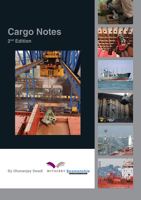Published: November 2022
This second edition reflects significant changes to the ways in which jackups are managed when afloat, such as those concerning design rules, regulations, guidelines and codes of practice. It includes changes to jackup moving operations, which are now conducted under a detailed and agreed Rig Move Procedure (RMP). This document clearly sets out the duties and responsibilities of the principal parties involved, the criteria to be used when making decisions regarding starting and stopping operations and the details of any sea passage to be undertaken. The book is appended with pre-move checklists and verified tow Master calculations.
This edition has been updated to include intricate technical illustrations, which have been annotated to reflect the steps involved in complex positioning operations. Factors such as weather criteria, seabed analysis and Certificate of Approval acquisition have also been included, making this a both a comprehensive and practical reference tool.
Table of Contents
Foreword vii
Introduction ix
Notes on Units of Measurement xi
1. Jackup Rigs
1.1 Moving Jackups
1.2 Rig Types in Operation
1.3 Structure of Rigs
1.4 Towing Arrangements On Board
1.5 Anchors
1.6 Positioning System Equipment
1.7 Survey Equipment
1.8 Correction and Misalignment – Elevated Operations
1.9 Location onto Subsea Templates/Wellheads – Wire Method
1.10 Marine Operations Manual
2. Tugs and Equipment
2.1 Overview of Tugs
2.2 Tugs
2.3 Anchor Handling Tugs
2.4 Small Seagoing Tugs/Multipurpose Tugs
2.5 Harbour Tugs
2.6 Towing Wires, Ropes, Pennants and Other Equipment
2.7 Tow Master’s Equipment
2.8 Towing Power Calculations
3. Jackup Move Plan and Process
3.1 Initial Stages
3.2 Outline of Jackup Rig Move Procedure (RMP)
3.3 Shoreside Hazard Identification and Risk Assessment (HIRA)
3.4 Pre-move Operations
3.5 Criteria for Towing
4. Emergency and Contingency Plans
4.1 Overview
4.2 Class Requirements
4.3 Emergency Plans
4.4 Contingency Plans
5. Jacking Down, Freeing Legs and Getting Afloat
5.1 Hazards Associated with Jacking Down and Getting Afloat
5.2 Jacking Down
5.3 Freeing Legs
5.4 Freeing Deeply Penetrated Legs
5.5 Connection of Tugs
5.6 Working in Areas of High Tidal Range
6. Towage
6.1 Hazards Associated with Towing Off Location
6.2 Manoeuvring with Tugs
6.3 Towage During Sea Passages
6.4 Passage Considerations
6.5 Passage Interfield – Short Distances
6.6 Port Towage
7. Float On/Off Heavy Lift Vessels (HLVs)
7.1 Hazards Associated with Floating On and Off an HLV
7.2 Use of Tugs
7.3 Use of HLV Lines
7.4 Responsibilities
7.5 Stability and Ballasting Operations
7.6 HLV Sea Fastenings
7.7 Securing Rigs for Barge or HLV Tows
8. Approach to Standoff Location
8.1 Hazards When Approaching Standoff Location
8.2 Picking up Towlines
8.3 Lowering Legs
8.4 Calculations for Standoff Location
8.5 Wavelength and Jacking
9. Jacking Gear and Jacking Operations
9.1 Overview of Jacking Gear
9.2 Precautions with Jacking Gear
9.3 Common Issues with Jacking Gear
9.4 Sequence of Jacking Operations
9.5 Decision Making Process – Jacking Criteria
9.6 Example for Checking Torque on Jacking Motors
10. Running Anchors
10.1 Hazards Associated with Running Anchors
10.2 Mooring Arrangements
10.3 Midline Buoy Procedures
10.4 Anchors
10.5 Winches and Mooring Wires
10.6 AHTS Setup for Working Anchors
11. Positioning at Location
11.1 Hazards Associated with Positioning
11.2 Open Location – Tug Deployment
11.3 Use of Stern Bridle
11.4 Tug Operations
11.5 Transit Between Standoff and Final Position
11.6 Positioning onto a Platform – Basic Method
11.7 Positioning onto a Platform – Complex Method
11.8 Walking onto a Final Position
11.9 Winch Operations
12. Preloading Operations
12.1 Hazards Associated with Preloading Operations
12.2 Procedures for Preloading
12.3 Monitoring of the Rig During Preloading Operations
12.4 Preloading – One Leg at a Time
12.5 Punch Throughs and Rapid Penetrations
12.6 Preloading Four-legged Jackups
12.7 Hydraulic Preloading
12.8 Preloading in Areas of High Tidal Range
12.9 Leg Footing Strength – Hard Seabeds
13. Rack Phase Differences (RPDs)
13.1 Overview 16913.2 Causes of RPDs
13.3 Existing Spudcan Holes
13.4 Repositioning a Jackup to Avoid RPDs
13.5 Measuring RPDs
13.6 Preventing RPDs from Causing Damage
13.7 Practical Solutions to RPDs
13.8 Leg Foundation Stability
13.9 Scour Considerations
14. Marine Warranty Surveyor
14.1 Overview
14.2 Certificate of Approval (CofA)
14.3 Weather Criteria
14.4 Site Investigation Hazards and Evaluation
15. Stability
15.1 Jackup Rig Stability
15.2 Calculating Leg Reactions
15.3 Motion Limits – Diagrams and their Use
15.4 Critical Motion Curves
15.5 Tug Stability
Appendices
Appendix 1: Calculating Leg Reactions
Appendix 2: Tow Master’s Approximate Calculations
Appendix 3: Selecting Tugs for Jackup Operations
Appendix 4: Pre-move Checklist
Appendix 4A: Tow Master (in conjunction with the OIM/barge Master)
Appendix 4B: OIM/barge Master (in conjunction with tow Master and rig Superintendent/Senior Toolpusher)
Appendix 4C: Barge engineer
Appendix 5: Daily Afloat Operations Checklist
Appendix 6: Rig Move Checklist
Appendix 7: Tow Master Checklist
Appendix 8: Soil Classification Table
Glossary of Terms
References
Practical Exercises






























